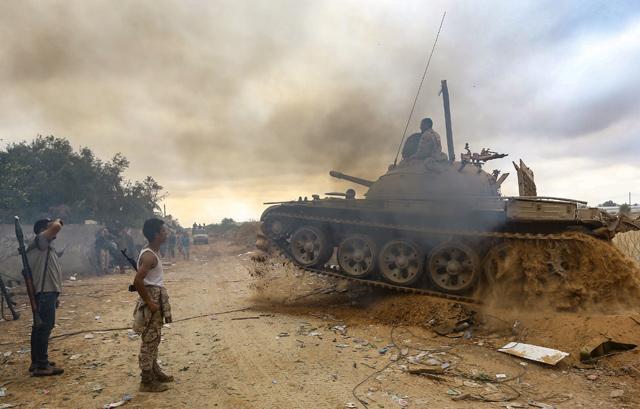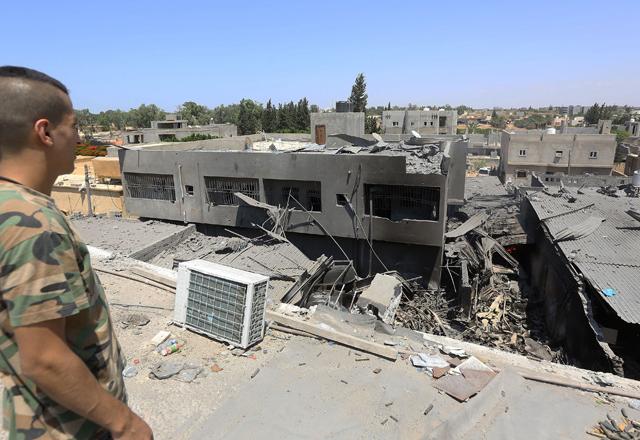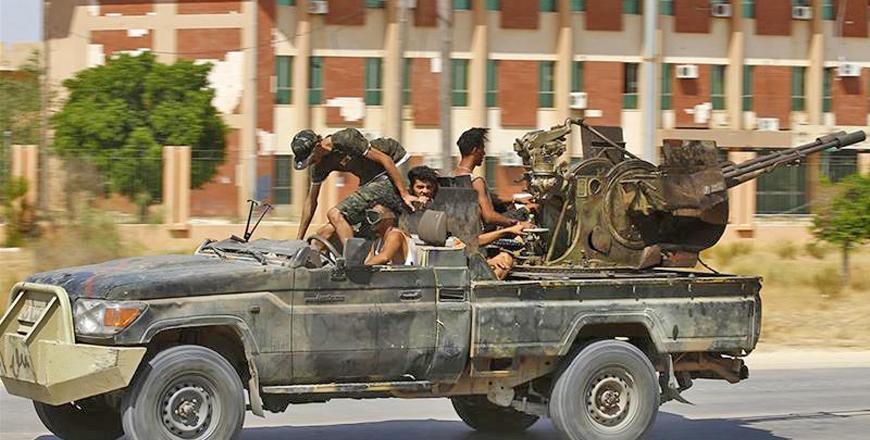You are here
Key dates in two-month battle for Libyan capital
By AFP - Jun 04,2019 - Last updated at Jun 04,2019

Fighters loyal to the internationally-recognised Libyan Government of National Accord are pictured near the frontline during clashes against forces loyal to strongman Khalifa Haftar in Al Sawani area, south of the Libyan capital Tripoli, on Saturday (AFP photo)
TRIPOLI — Two months ago Libya's military strongman Khalifa Haftar launched an offensive to seize the capital Tripoli, the seat of the internationally recognised government.
The United Nations says more than 600 people have been killed and 3,200 others wounded in the fighting, which has forced 80,000 people to flee their homes.
Here is a recap.
Offensive starts
In an online message launching the campaign by his self-styled Libyan National Army (LNA) to take Tripoli, Haftar says on April 4: "The time has come."
His forces claim they are acting against "terrorists and mercenaries".
The retired general, who has set up a parallel administration in eastern Libya and controls major oil fields, refuses to recognise a Government of National Accord (GNA) meant to end years of chaos since the killing of Muammar Qadhafi in 2011.
As Haftar's forces begin their advance, the Tripoli-based GNA announces a "state of maximum alert".
Its chief, Fayez Al Sarraj, orders loyalist forces to prepare to "face all threats".
Haftar's forces briefly seize Tripoli's international airport, unused since it was destroyed in fighting in 2014, but are pushed back on April 5.
UN Secretary General Antonio Guterres meets Sarraj and Haftar, saying afterwards he is "deeply concerned".
Air strikes
On April 6, forces backing the GNA launch the first air strikes on LNA positions around 50km south of Tripoli.
The next day Haftar's forces say they carried out their first air strike on a Tripoli suburb.
Pro-GNA forces announce a counteroffensive called "Volcano of Anger".
On April 8, LNA warplanes carry out an air strike against Tripoli's only functioning airport, Mitiga.
The LNA accuses the unity government of "allying itself with Islamist militias".
Rockets hit central Tripoli late on April 16, for the first time since the offensive was launched and killing six people. The LNA is blamed.
On April 18, the UN's Libya envoy, Ghassan Salame, warns, of "a widening conflagration".
International involvement
On April 19, the White House reveals that President Donald Trump spoke with Haftar by phone and recognised his "significant role in fighting terrorism and securing Libya's oil resources".
Clashes south of Tripoli intensify.
On April 24, Sarraj accuses France of backing Haftar, saying its support prompted him to move on Tripoli and abandon a political solution. France rejects the accusations.
On May 7, a report to the UN Security Council says experts believe that missiles used by the LNA or its allies may have been supplied by the United Arab Emirates.
Haftar visits Egypt on May 9 for the second time since his offensive began. Sarraj meanwhile tours Europe to shore up support.
On May 18, the GNA boasts of new weapons despite an arms embargo on the country. It does not detail where they have come from.
‘Civil war’
On May 21, violent clashes rage south of Tripoli in the most intense fighting since May 6, just as the Muslim holy month of Ramadan began.
The UN envoy, Salame, warns the Security Council that without immediate action by the international community "Libya will descend into civil war which could potentially lead to a... partition of the country."
On May 22, Haftar rejects a ceasefire requested by French President Emmanuel Macron, saying the conditions for halting hostilities "were not met".
On May 26, Haftar says his troops will continue their offensive until militias in Tripoli lay down their arms.
He also takes aim at Salame, saying he has become a "biased" mediator.
Related Articles
TRIPOLI — Libya’s military strongman Khalifa Haftar launched an offensive three months ago to seize the capital, the seat of the internation
TRIPOLI — The battle for Libya's capital intensified as the UN Security Council prepared to meet Wednesday to discuss the crisis gripping th
TRIPOLI — Libya's UN-recognised government, based in Tripoli, has been under attack since April 2019 by forces of military strongman Khalifa

















